If you’re looking for a way to treat your staph infection, antibiotics can be a highly effective option. Staph infections can range from mild to severe, and in some cases, they can even be life-threatening. With so many different antibiotics available, it can be difficult to determine which one is the best for treating staph infections.
Before choosing an antibiotic, it’s important to consider a few factors. Firstly, the type and severity of the infection will influence the type of antibiotic needed. For example, MRSA (methicillin-resistant Staphylococcus aureus) infections require stronger antibiotics than typical staph infections. Additionally, some antibiotics may not be suitable for people with certain allergies or medical conditions. It’s best to consult with a healthcare professional before taking antibiotics.
When selecting an antibiotic, it’s important to ask questions and do research. What are the potential side effects? How long will treatment take? Is this antibiotic commonly prescribed for this type of infection? By arming yourself with knowledge, you can make an informed decision about your treatment options.
Overall, antibiotics remain a popular and effective treatment for staph infections. However, it’s important to note that they should only be used under the supervision of a healthcare professional. If you’re experiencing symptoms of a staph infection, seeking medical attention promptly can help ensure a quick and effective recovery.
10 Best Antibiotic For Staph Infection
| # | Product Image | Product Name | Product Notes | Check Price |
|---|---|---|---|---|
|
1
|
Ideal for killing Staph aureus on skin contact.
|
|
||
|
2
|
Ideal for killing Staph aureus on skin contact, verified by lab certification.
|
|
||
|
3
|
It is ideal for killing Staph aureus on skin contact.
|
|
||
|
4
|
It is ideal for treating minor skin injuries and preventing infection.
|
|
||
|
5
|
Ideal for preventing infection in minor wounds and promoting healing.
|
|
||
|
6
|
This product is ideal for treating minor wounds, scratches, and abrasions with 24-hour protection using zinc, neomycin, and polymyxin.
|
|
||
|
7
|
The product is ideal for preventing infection in minor wounds and promoting healing.
|
|
||
|
8
|
This product is ideal for treating minor scratches and wounds while preventing infection, comparable to leading brands.
|
|
||
|
9
|
Ideal for cleansing and treating wounds such as cuts, scrapes, burns, diabetic ulcers, and pressure sores with antimicrobial and antibacterial properties.
|
|
||
|
10
|
It is an all-purpose ointment for treating various skin ailments such as bee stings, mosquito bites, boils, splinters, and more.
|
|
1. B-Phree Gel Bacteria Wash (32oz) – Lab-Certified To Kill Staph Aureus On Skin Contact
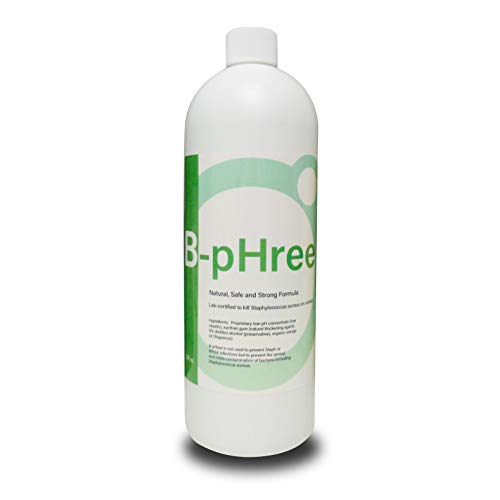
Introducing B-pHree, a lab-certified cleaning product that effectively eliminates Staphylococcus aureus on contact. Its proprietary high acidity, low caustic concentrate is a powerful formula that relies on the natural power of pH to eradicate bacteria effectively without relying on harsh toxins.
Maintaining a hygienic environment is crucial, and B-pHree helps you achieve that. Use it after taking a shower and follow it up with clean towels, fresh linens, and clothes to enjoy a germ-free environment. With B-pHree, you can have peace of mind knowing that you are taking every step necessary to protect yourself and your loved ones from harmful bacteria.
The product's unique formula is designed to be gentle on surfaces and safe for use around children and pets. It doesn't contain any toxic chemicals, making it an eco-friendly solution that doesn't pose any harm to the environment.
The packaging for B-pHree may vary from the image, but you can rest assured that the product inside is of the highest quality. With its lab-certified efficacy and powerful cleaning properties, B-pHree is a must-have for anyone who values cleanliness, hygiene, and safety.
2. Spencer's Gel Alkaline Formula (8oz) – Lab-Certified To Kill Staph Aureus On Skin Contact
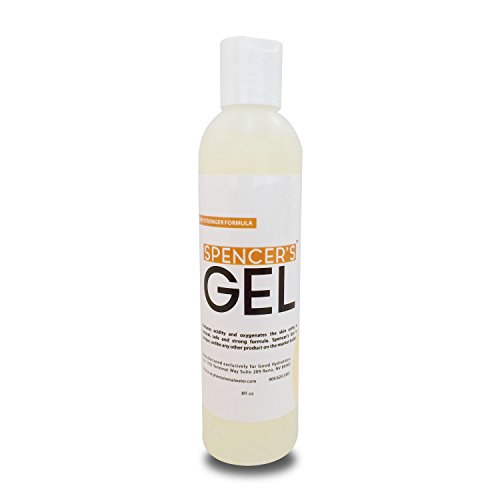
This specialized gel is specifically designed for individuals suffering from open wounds caused by MRSA or folliculitis. It is important to note that this product is not intended to prevent the spread of Staph or MRSA nor is it meant to be used as an antibacterial cleanser. Instead, it is formulated to address pre-existing skin issues caused by acid-loving bacteria. By altering the pH balance of the affected area, the gel reduces acidity, allowing the immune system to effectively combat the bacteria and promote healing.
Users of this product can expect to see noticeable results in a short amount of time. The gel features a high alkalinity concentrate that is non-caustic and gentle on the skin. Additionally, the product is enriched with organic citrus oil, which provides a pleasant and refreshing fragrance.
This specialized gel is a safe and effective option for individuals dealing with MRSA or folliculitis-related skin problems. It is important to follow the usage instructions carefully and use as directed to achieve the best possible results. With regular use of this innovative product, users can experience relief from painful and unsightly skin issues.
3. Spencer's Gel Alkaline Formula (4oz) – Lab-Certified To Kill Staph Aureus On Skin Contact
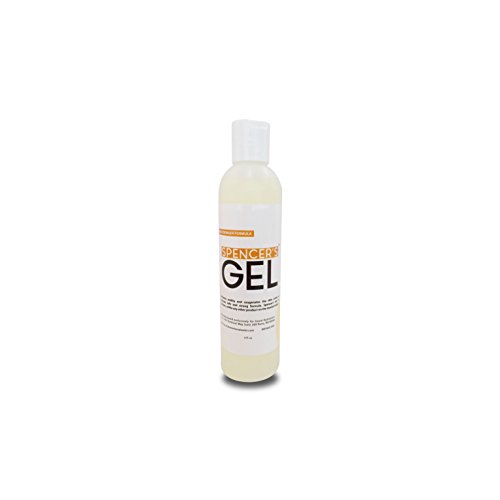
The Staph or MRSA infection can be a cause of concern for many individuals. For those who are already suffering from it, this product is designed to aid in the healing process. The gel is specifically formulated for use on open Staph or MRSA wounds and folliculitis.
It is important to note that this gel is not meant to be used as a preventative measure against Staph or MRSA, nor is it intended to be used as an anti-bacterial cleanser. Instead, it is designed to help pre-existing skin problems caused by acid-loving bacteria. By reducing the acidity, the immune system can effectively target the bacteria, allowing the body to heal quickly.
One of the most remarkable features of this gel is its high alkalinity concentrate which is non-caustic, making it gentle on the skin. Additionally, it has an organic citrus oil fragrance that adds a refreshing scent to the product.
Users of this product can expect to see results quickly, making it an ideal solution for those who are seeking relief from Staph or MRSA infections. Overall, this product is a great option for those who are looking for an effective solution to help heal their skin.
4. Polysporin First Aid Antibiotic Ointment Without Neomycin, Travel Size, 1 Oz Tube
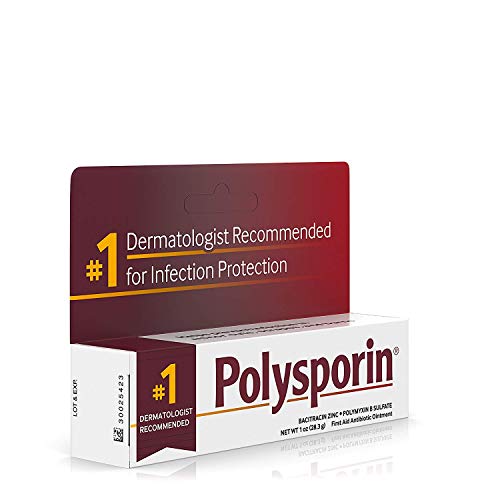
The Polysporin First Aid Antibiotic Skin Ointment is a highly effective topical ointment that provides infection prevention for minor wounds. This ointment comes in a 1-ounce tube, making it easy to carry around and use whenever necessary. It is recommended by dermatologists as the number one first aid ointment for infection prevention.
This wound care ointment is specifically designed to prevent infection in minor cuts, scrapes, and burns. It contains bacitracin zinc and polymyxin B sulfate, which work together to provide the necessary protection against harmful bacteria. Moreover, it does not contain neomycin, making it suitable for people who may be allergic to this ingredient.
The Polysporin First Aid Antibiotic Skin Ointment is very easy to use. Simply apply a small amount of the ointment onto the affected area and cover it with a sterile bandage. This will help keep the wound clean and prevent further infection. Additionally, this antibiotic ointment is available in a TSA-friendly travel size, making it ideal for on-the-go first aid and wound care.
This product comes in a 1-pack of 0.5-ounce tubes, which is perfect for individuals who need to keep a tube of first aid ointment in their purse, car, or at their desk. It is important to note that if the ointment is swallowed, medical help or Poison Control Center should be contacted right away.
5. Neosporin Original Antibiotic Ointment, 24-Hour Infection Prevention For Minor Wound.5 Oz
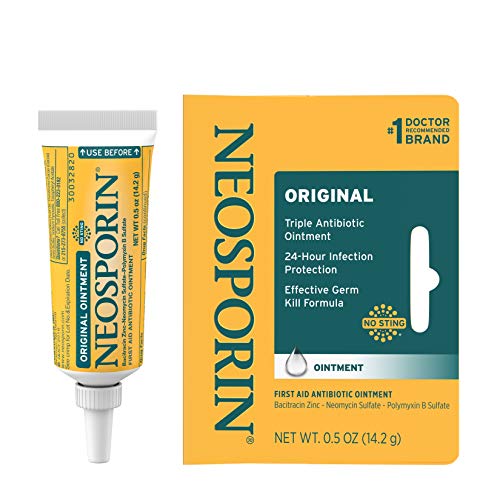
The Neosporin Original Topical Antibiotic Ointment is a trusted first-aid treatment for minor cuts, scrapes, and burns. Each package contains 0.5 ounces of the wound care ointment formulated with neomycin sulfate, bacitracin zinc, and polymyxin B antibiotic ingredients that provide 24-hour infection protection for minor wounds.
This topical first-aid ointment also contains HeliDerm Technology that creates a nourishing environment for the skin to heal, resulting in healthier-looking skin after use. It helps minimize the appearance of scars after the wound has healed.
Using the Neosporin Original Topical Antibiotic Ointment is easy. Apply a small amount of the ointment to the affected area 1 to 3 times daily. For extra protection, cover the wound with a Band-Aid Brand Adhesive Bandage.
This wound care ointment provides a quick and effective solution for minor injuries, making it a must-have in any first-aid kit. Its compact size makes it easy to carry wherever you go, ensuring that you are always prepared for unexpected injuries.
6. Medpride Wound Guardian: 4-Pack Antibiotic Ointment
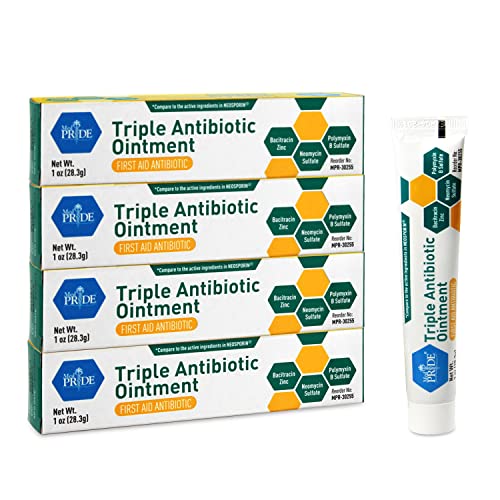
Every household should have a reliable first-aid kit, and the Triple Antibiotic Cream is an essential addition. This cream is specially formulated to treat minor cuts, scrapes, burns, and wounds, preventing infections from taking hold and spreading.
The Triple Antibiotic Cream is a potent, triple-action ointment that provides 24-hour protection from potential infections. It contains three active ingredients, including Bacitracin Zinc, Neomycin Sulfate, and Polymyxin B Sulfate, which work together to provide first-aid care. These ingredients work by stopping or preventing bacterial infections by killing susceptible bacteria or inhibiting their growth process.
In addition to its antibacterial properties, this cream also nourishes and hydrates the skin. It provides the first layers of skin with nutrition, which minimizes the appearance of scars and results in healthier-looking skin after the healing process.
Using the Triple Antibiotic Cream is simple and quick. First, clean the affected area and apply a small amount of the ointment 1 to 3 times daily. For accelerated healing, cover the wound with a sterile bandage.
Remember, prevention is better than treatment. By using this first-aid ointment, you can prevent infections from taking hold and spreading. With its triple-action formula, the Triple Antibiotic Cream is a reliable addition to your first-aid kit.
7. Neosporin Original Antibiotic Ointment, 24-Hour Infection Prevention For Minor Wound, 1 Oz
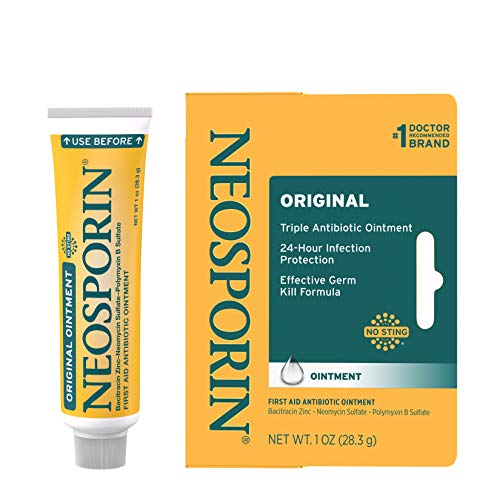
The Neosporin Original Topical Antibiotic Ointment is a reliable wound care solution for treating minor cuts, scrapes, and burns. It contains a potent combination of neomycin sulfate, bacitracin zinc, and polymyxin B antibiotic ingredients that provide 24-hour protection against infections.
This topical first-aid ointment not only protects but also nourishes the skin to minimize the appearance of scars after healing. It is formulated with HeliDerm Technology that creates a nourishing environment for the skin to heal, resulting in healthier-looking skin after use.
To use, simply apply a small amount of the first-aid antibiotic ointment to the affected area one to three times daily. For extra protection, cover the wound with a Band-Aid Brand Adhesive Bandage.
This Neosporin ointment comes in a 1-ounce tube that is easy to carry and store. It is perfect for keeping in a first-aid kit, at home, or in the office.
8. Antibacterial Triple Ointment For First Aid Wounds.
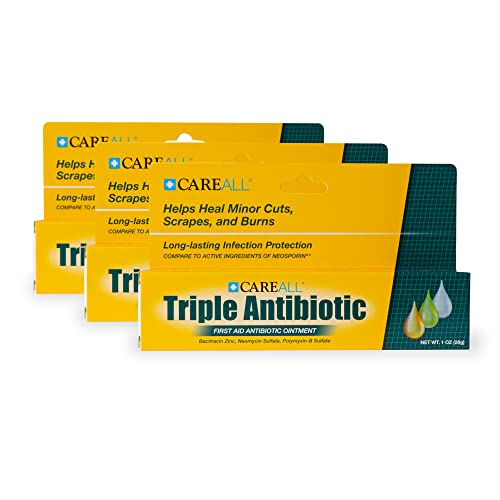
This first-aid ointment is an effective solution for healing minor cuts, scrapes, and burns. It provides 24-hour protection against infections in wounds, ensuring that they heal properly. The product contains active ingredients that are comparable to those found in leading brands. Each gram of the ointment contains Bacitracin Zinc 400 units, Neomycin Sulfate 5mg (equivalent to 3.5mg of Neomycin base), and Polymyxin B Sulfate 5,000 units.
The 1oz tube of ointment is tamper-proof, with a foil safety seal that ensures the product remains secure and uncontaminated until it is opened. The product is FDA registered, with a National Drug Code Number (NDC#) printed on the packaging, along with a LOT# and Expiration Date. It is important to note that this product is for external use only.
This first-aid ointment is an essential item to have on hand for any household or workplace. It provides peace of mind knowing that minor injuries can be effectively treated with a product that has been proven to work. The active ingredients in the ointment work together to fight off infections and promote healing, ensuring that wounds are properly cared for.
9. Berberex Wound Spray – Your Ultimate Antimicrobial Solution

Introducing the clinically proven BerbereX Antimicrobial Wound Cleanser, a safe and effective solution for healing cuts, burns, incisions, scrapes, and wounds of all kinds. This powerful formula is specially designed to prevent infection and promote faster healing, making it an essential item for every first aid bag and kit.
Formulated with a safe and non-irritating antimicrobial solution, BerbereX is a reliable first aid antiseptic spray that helps to kill bacteria and protect the skin from further damage. Backed by clinical research and recommended by doctors, this FDA registered formula is proven to be effective in cleansing acute and chronic wounds of all stages.
BerbereX allows for fast, thorough, and gentle cleansing of wounds, reducing the risk of infection and promoting faster healing. It also helps to calm redness, inflammation, and discomfort, reducing the risk of scarring and leaving your skin looking and feeling better than ever before.
Whether you're dealing with skin sores, pressure sores, bed sores, or diabetic ulcers, BerbereX is the perfect solution for promoting healing and protecting your skin. So why wait? Add BerbereX Antimicrobial Wound Cleanser to your first aid kit today and experience the difference for yourself!
10. Nature's First Aid For Skin
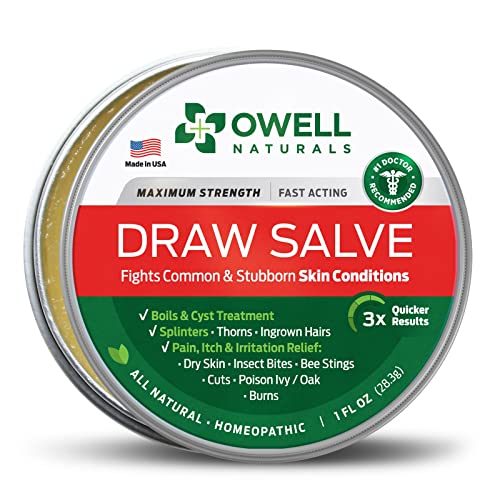
Owell Naturals Drawing Salve has been a trusted remedy for wound healing for centuries. The salve utilizes an authentic Amish formula that has stood the test of time. This salve is three times better than ichthammol and is the most effective ointment for drawing out ingrown hair, boils, cysts, splinters, abscesses, ingrown toenails, glass, and lipoma. It creates a thick protective barrier that helps prevent infection and keeps germs out.
This salve is the number one choice for skin discomforts and insect bites. It has been professionally formulated to help relieve pain, burns, skin eruptions, irritations, itchy skin, mosquito and spider bites, bee stings, poison ivy/oak, and bug and insect bites. It is safe and gentle on the skin, with a natural fresh honey lavender scent and smooth consistency. The salve is made using only 100% natural ingredients and is non-GMO, made in the USA, vegan, paraben-free, and not tested on animals.
The secret to the effectiveness of Owell Naturals Drawing Salve is the unique blend of essential oils used in the authentic Amish formula. The salve includes beeswax, chickweed, lavender, eucalyptus, comfrey, pine, and olive oil. These essential oils work together to create a powerful healing formula that draws out impurities and promotes the body's natural healing process.
Best Antibiotic For Staph Infection FAQs
Are there any alternative treatments to antibiotics for staph infections?
Yes, there are alternative treatments to antibiotics for Staph infections. Antibiotic resistance is a growing concern in the medical community, and alternative treatments can be effective in reducing the need for antibiotics. Some of these alternative treatments include:
1. Manuka honey: This is a type of honey that has antibacterial properties and has been shown to be effective against Staph infections.
2. Essential oils: Some essential oils, such as tea tree oil, oregano oil, and lavender oil, have antibacterial properties and can be used to treat Staph infections.
3. Probiotics: Probiotics can help boost the immune system and fight off Staph infections.
4. Garlic: Garlic has natural antibacterial properties and can be used to treat Staph infections.
5. Vitamin C: Vitamin C can help boost the immune system and fight off Staph infections.
It is important to note that alternative treatments should be used in conjunction with medical treatment and under the guidance of a healthcare professional. If left untreated, Staph infections can lead to serious complications, so it is important to seek medical attention if you suspect you have a Staph infection.
Are there any side effects associated with taking antibiotics for staph infections?
Yes, there can be side effects associated with taking antibiotics for staph infections. Antibiotics are powerful medications that are designed to fight bacterial infections, but they can also have an impact on the body's natural balance of bacteria. Some common side effects of antibiotics include nausea, vomiting, diarrhea, and stomach pain. In addition, antibiotics can also lead to allergic reactions, such as hives, difficulty breathing, and swelling of the face, lips, tongue, or throat.
It's important to note that not all antibiotics are the same and some may have more severe side effects than others. Before taking any medication, it's important to speak with your healthcare provider about the potential side effects and risks associated with the medication. They can help you weigh the benefits and risks of taking antibiotics and determine the best course of treatment for your individual needs.
Can antibiotics be taken orally or are they given through an IV for staph infections?
Antibiotics can be administered both orally and through an IV for staph infections. The route of administration depends on the severity of the infection and the patient's overall health condition. Oral antibiotics are usually prescribed for mild to moderate staph infections, and patients can take them at home. However, if the infection is severe or if the patient cannot tolerate oral antibiotics, intravenous antibiotics may be necessary. In such cases, the patient will need to be hospitalized to receive the antibiotics through an IV. It's important to note that antibiotics should only be taken as prescribed and for the entire duration of treatment to ensure the infection is fully eradicated. Failure to complete the full course of antibiotics can lead to antibiotic resistance, which can make treatment more difficult in the future. Therefore, it's crucial to follow the doctor's instructions and complete the full course of antibiotics as prescribed.
Can staph infections become antibiotic-resistant and how is this treated?
Yes, staph infections can become antibiotic-resistant, which means that the bacteria causing the infection are no longer affected by the antibiotics that are typically used to treat them. This is due to the overuse or misuse of antibiotics, which can cause the bacteria to adapt and develop resistance to the drugs.
When a staph infection is antibiotic-resistant, alternative treatments must be used. This may include stronger antibiotics that are not typically used as first-line treatments, or a combination of antibiotics. In some cases, surgical removal of the infected tissue may be necessary.
Preventing the spread of antibiotic-resistant staph infections is crucial in reducing their prevalence. This can be achieved by practicing good hygiene, such as washing hands regularly, covering wounds, and avoiding close contact with infected individuals. It is also important to use antibiotics responsibly and only when necessary, to avoid contributing to the development of antibiotic resistance.
How long does it typically take for antibiotics to clear up a staph infection?
The length of time it takes for antibiotics to clear up a staph infection can vary depending on the severity of the infection and the type of antibiotics being used. Generally, staph infections are treated with antibiotics for a period of 7 to 14 days, however, more severe infections may require a longer course of treatment.
It is important to note that antibiotics must be taken as prescribed and for the full duration of treatment in order to effectively clear the infection. Failure to complete the full course of antibiotics can result in the infection returning and potentially becoming more severe.
In addition to antibiotics, it may be necessary to drain any abscesses or infected wounds in order to fully clear the infection. It is important to follow proper wound care procedures and to keep the affected area clean and dry to prevent the spread of the infection.
If you suspect you have a staph infection, it is important to seek medical attention promptly in order to receive an accurate diagnosis and appropriate treatment.
Is it necessary to culture the infected area to determine the best antibiotic for a staph infection?
Yes, it is necessary to culture the infected area to determine the best antibiotic for a staph infection. Staphylococcus aureus, the bacterium responsible for most staph infections, has become increasingly resistant to antibiotics, making it important to identify the specific strain causing the infection and the antibiotics to which it is susceptible. Culturing the infected area involves taking a sample of the pus or tissue and growing it in a laboratory to identify the type of bacteria causing the infection. Once the type of bacteria is identified, susceptibility testing can be performed to determine the most effective antibiotic treatment. This is important because using the wrong antibiotic can lead to antibiotic resistance, prolonged infection, and potentially life-threatening complications. Therefore, culture and susceptibility testing is necessary to guide effective antibiotic therapy and prevent the spread of antibiotic-resistant strains of staph.
What are the recommended antibiotics for staph infections caused by methicillin-resistant Staphylococcus aureus (MRSA)?
Treatment of methicillin-resistant Staphylococcus aureus (MRSA) infections can be challenging due to the organism's resistance to many antibiotics. The choice of antibiotics depends on the severity of the infection, the patient's overall health status, and the local resistance patterns. The most commonly used antibiotics for MRSA infections are vancomycin, linezolid, daptomycin, and ceftaroline. Vancomycin is the most commonly used antibiotic for MRSA infections, and it is given intravenously. Linezolid is an oral or intravenous antibiotic that is effective against many strains of MRSA. Daptomycin is another intravenous antibiotic that is used to treat MRSA infections, especially in cases where vancomycin is not effective. Ceftaroline is a newer intravenous antibiotic that is approved for the treatment of skin and soft tissue infections caused by MRSA. In some cases, a combination of antibiotics may be used to treat MRSA infections. It is important to follow the prescribed course of antibiotics and to complete the full course of treatment to ensure that the infection is fully treated.
What factors should be considered when selecting the best antibiotic for a staph infection?
When selecting the best antibiotic for a staph infection, several factors need to be considered. First, the type of staph infection needs to be identified, as this will determine the appropriate antibiotic. Methicillin-resistant Staphylococcus aureus (MRSA) infections require different antibiotics than methicillin-susceptible Staphylococcus aureus (MSSA) infections.
Second, the patient's medical history and current health status need to be taken into account. Certain antibiotics may interact with other medications the patient is taking or may not be suitable for patients with certain medical conditions.
Third, the antibiotic's efficacy, safety, and route of administration need to be considered. Some antibiotics have a higher risk of adverse effects, while others may be more effective in treating certain types of staph infections. The route of administration, such as oral or intravenous, may also depend on the severity of the infection.
Finally, the antibiotic's resistance patterns should be considered to ensure that it will effectively treat the staph infection. The use of broad-spectrum antibiotics should be avoided whenever possible to prevent the development of antibiotic resistance.
What is the most effective antibiotic for treating a staph infection?
The most effective antibiotic for treating a staph infection depends on the type of staph bacteria causing the infection and its susceptibility to different antibiotics. Methicillin-resistant Staphylococcus aureus (MRSA) is a type of staph bacteria that is resistant to many antibiotics, including methicillin, penicillin, and amoxicillin. In such cases, antibiotics such as vancomycin, daptomycin, or linezolid may be used. For non-MRSA staph infections, antibiotics such as clindamycin, trimethoprim-sulfamethoxazole, or doxycycline may be effective. It is important to note that antibiotic resistance is becoming a significant problem and overuse of antibiotics can contribute to this. Therefore, it is essential to consult a healthcare professional for proper diagnosis and treatment of any bacterial infection. They can determine the most effective antibiotic and prescribe the appropriate dosage and duration of treatment.
What is the recommended duration of antibiotic therapy for staph infections?
The duration of antibiotic therapy for staph infections varies depending on the severity of the infection and the type of staph bacteria causing it. For mild staph infections, such as skin infections, a course of antibiotics for 7-10 days may be sufficient. However, for more severe infections such as bloodstream infections or endocarditis, a longer course of antibiotics, up to 6 weeks, may be necessary. The choice of antibiotic also depends on the type of staph bacteria causing the infection, as some strains have developed resistance to certain antibiotics. It is important to complete the full course of antibiotics prescribed by your healthcare provider, even if you start feeling better before the medication runs out, to prevent the infection from recurring or becoming resistant to antibiotics. It is also advisable to follow good hygiene practices, such as washing hands regularly, to prevent the spread of staph infections.

